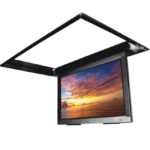Table of Contents
These days, nobody wants the tiresome and time-consuming manually planting seeds in extensive gardens.
So, it’s not surprising that many people are ditching manual farming methods for garden seeders and drills.
After all, they’re typically faster than manual processes and are easier to use.
Planting drills are classified into two: tillage drills and no-till drills. This article will review the best no-till drills for pasture available today.
Some no-till drills are designed exclusively for seed planting. Others are versatile enough to combine seed planting and fertilizer application.
Here’s a detailed review of our best no-till drills for pasture and how they rank among users.
Best No-Till Drills For Pasture – Reviews
Claydon M3 Hybrid Drill Range
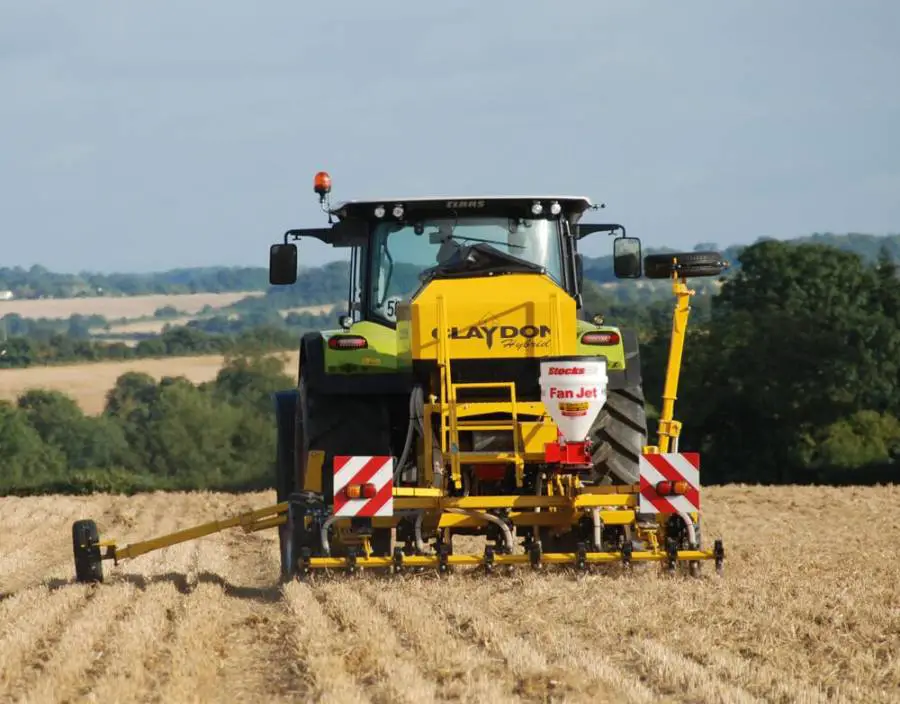
This hybrid drill range from Claydon features a split hopper design which puts it ahead of market specifications and expectations.
But beyond the physical design, the new levels of operational functionality that this hybrid drill features are increasing its popularity.
Its unique design puts it at the top for growers who want a top pasture no-till drill that increases productivity, reduces the price, and improves soil health.
But that’s not all. For a drill that features a sleek design, one will expect excellent functionality.
Rightly so, the Claydon 3m drill comes loaded with several features to deliver top-level functionality.
A 1750 hopper and 150hp power requirements help ensure that the M3 can drill up to 20 hectares a day.
Its complete range of seeding setup options and real toolbars will allow more effortless operation.
How It Works
One of the first things that’ll catch your attention is the extra set of easily adjustable depth wheels.
It has five-time settings where you can alter interaction with soil type. The lead tine cuts a groove in the soil at 100mm.
The hydraulic reset feature of the tine will help mitigate the effects of broken shear bolts caused by stony grounds.
An easily visible winged point slices through the soil’s top profile, throwing out materials on both sides.
The two tubes behind this part serve as the channel for the seed to drop into the soil. Another pipe before the rear paddle dispenses fertilizer according to settings.
What We Like About This Product
- The design of this pasture no-till drill is top-notch, with enough facilities to support the hopper’s weight.
- The calibration system is easy and accurate.
- Very versatile drill for planting and fertilizing.
- Four-depth wheels to support precise placement.
What We Dislike About This Product
- The hoppers’ design makes cleaning somewhat awkward.
- The tank often blocks the rearview.
John Deere 750A

Easily regarded as one of the most versatile no-till drills for pasture in the market, the John Deere 750A can plant tiny seeds, turnips, and chicory.
Interestingly, you don’t need any tools to achieve these. Just reset the metering system to suit your purpose, and you’re good to go.
Unlike many other top no-till drills, this one is equipped to deal with annual and perennial ryegrass.
The machine can handle a sowing rate of 400kg per hectare, but that’s up to you. You can set it to suit your needs.
One of the first things you’ll notice with this drill is its robust build. The design makes it suitable for heavy workloads.
It’s also worth mentioning how versatile this drill is. It has a single disc opener that allows efficient operation in a high trash environment.
Notwithstanding, you’d still enjoy working in other conditions. Let’s also mention that it’s a seed-only drill.
So, there’s no separate hopper built for fertilizer distribution.
A hydraulic-driven fan delivers the seed from the metering system at about 3000rpm and 4000rpm for the three-meter and four-meter drills.
While reviewing this drill, we were impressed that this machine is designed to work efficiently with low horsepower tractors.
Of course, contracting runs at relatively low horsepower, but it makes up for the horsepower shortage with an ability to navigate tight corners and less ground compaction.
However, with the drill hoppers mounted high, we realized that getting heavier bags of seeds up the hopper takes quite an effort.
But that shouldn’t be a big problem since you can always use a trailer or tractor bucket.
If you’re worried about restocking seeds in the extended hopper, don’t worry, that’s not too difficult.
An available ladder and platform make it easier to open the hopper lid.
What We Like About This Product
- Minimal ground disturbance.
- Its versatility means that it works for sowing different types of seeds.
- The reliability of the seed-to-soil contact enables more consistent germination.
- Easily adjustable seed depths.
What We Dislike About This Product
- It doesn’t work for fertilizer disbursement.
- The drill’s length makes for more challenging maneuvering.
Varomorus Metal Precision Manual Seeder

Another versatile no-till drill for growing pasture is the Varomorus Metal Precision Manual Seeder.
Although it is a manual drill, its numerous heavy-duty features rank it side-by-side with today’s automatic options.
Perhaps, the first thing you’ll see on most blogs about this drill is its versatility. It works for planting anything ranging from fruits to vegetables.
Like all the other options in this list, it is designed with heavy-duty materials. This particular design allows it to withstand rough usage.
Besides, it’ll also last through different weather conditions.
This Varomorus manual seeder comes with 5-row seeder options, so you can adjust the seeder plates to suit your desired crop row.
And yes, the seeder’s compact and lightweight style allows for convenience when working on different soils.
So it’s not just versatile for plants; it also works on several different soil types.
It also has an adjustable sowing brush limiter to suit the number of seeds required. Overall, we found that this multi-row seeder works efficiently on in-ground gardens.
However, there have been many complaints about how it works on wet soil. But that’s something you can maneuver with the seeder adjustments to suit your work.
The drill offers up to 20 nozzles that range from three to four millimeters each.
It’s an excellent option if you’re working with tiny seeds like radishes, beets, greens, and carrots.
What We Like About The Product
- Its adjustable seeder design allows for a more uniform seeding while giving the seeds the needed depth.
- A durable body supports heavy-duty operations.
- Covers a sizeable per-capita square of land.
What We Don’t Like About This Product
- It doesn’t work as efficiently as it should on wet ground.
- The seed hampers don’t come with any covers.
- Changing the seed disks can often get somewhat more complex.
Primewest Cross Slot
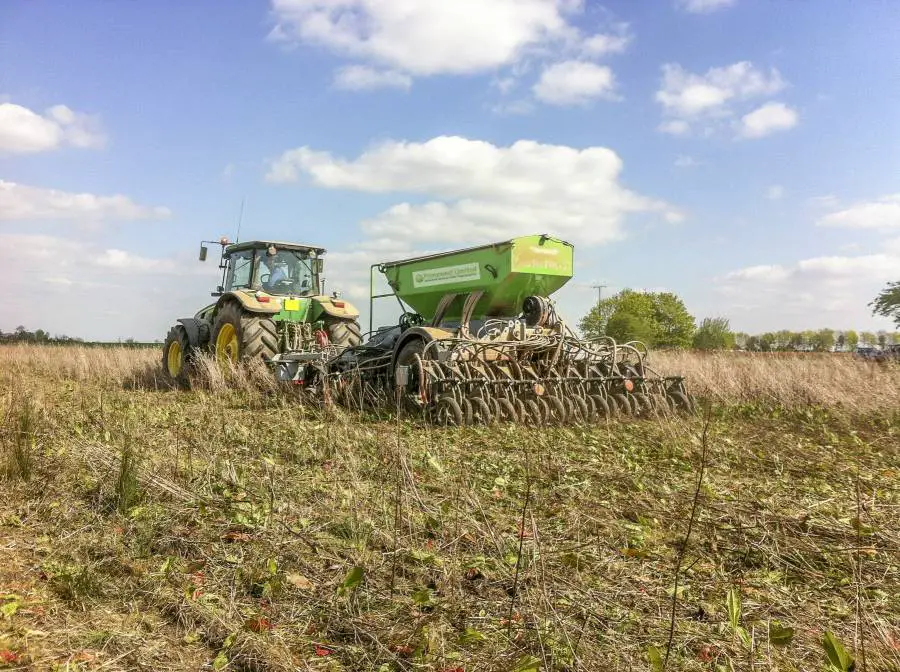
Most people know Primewest for its legendary revolution of no-tills for pasture, especially with the incorporation of Kiwi technology in all its drills.
The British manufacturer has been making top no-till drills for pasture since 2013, so you’d expect an incredible level of innovation in the Cross Slot design.
The brand advertises this machine as one of the most durable in the industry. Rightly so, the Cross Slot features a durable design that makes it a long-term investment.
Like most other options in this list, the Cross Slot can plant into any situation.
Its open design makes it a fascinating choice for areas with vast amounts of residues.
The machine features a 22-inch vertical disc designed to cut through residues and create a slot easily.
Two L-shaped clusters flank on either side of the disc for fertilizer and seed placement.
One of the first things you’ll notice about this machine is the presence of an Auto Down Force option.
This option automatically adjusts pressure to suit a preset target.
Another easily noticeable feature is the pneumatic 3-in press wheel that follows behind to firm the slot.
Perhaps the most significant benefit of this opener is the massive reduction in soil disturbance.
This feature allows seeds to enter the proper depth and get covered with clean, trash-free soil.
At 13.5-litres/ha, the machine burns significantly less fuel than most other options. However, one area that users are not satisfied with is the weight of this machine.
It means that it needs heavier tractors with more horsepower to pull along.
What We Like About This Product
- It places seeds at a consistent depth without hair-pinning.
- Works well in all kinds of soil.
- The T-shaped slot features an innovative design that further improves growing conditions.
- Minimal weed seed disturbances.
What We Dislike About This Product
- It is a pretty expensive
Pöttinger AEROSEM FDD
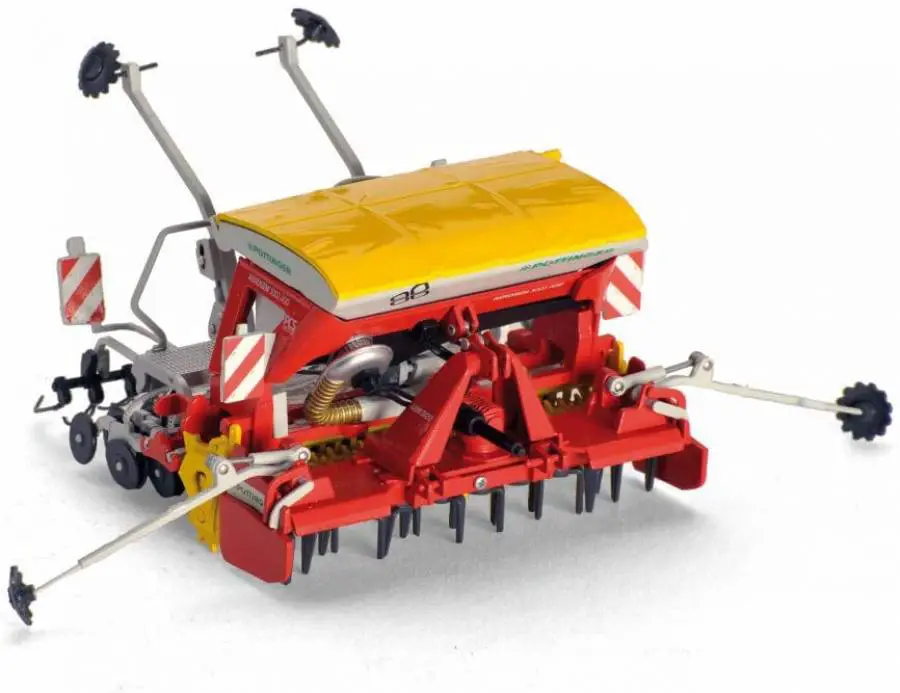
Pöttinger, another specialist in seed drill technology, quickly makes our list of top no-till drills for pasture with the Pöttinger AEROSEM FDD.
The pneumatic seed drill has a working width of 4.0 and 5.0 m and is available as a folder version with a front hopper.
The unique front hopper design that this machine feature opens up two new applications:
- It has an airtight cover that ensures the transportation of seeds back to the counter rail at a reasonable metering flow rate.
- The hopper’s 1,700 liters volume makes for more seed-carrying capacity.
One look at the machine, and you can tell that the manufacturers emphasized easier handling and accessibility during the loading and calibrating process.
There’s also a service platform that allows for clearer visibility into the hopper.
The front hopper comes in two metering units designs:
- A single metering unit.
- A dual metering unit.
While the first one is smaller and easier to maneuver, it only supports seed planting.
On the other hand, the dual metering unit lets you apply seeds and fertilizers in one pass. It means more flexibility.
Overall, we find the machine easy to operate. A compact folding colter rail provides an optional hydraulic lifting system for better ground clearance.
Additionally, this colter rail design shifts the center of gravity closer to the tractor.
Another exciting feature of this system is the available adjustment options (mechanical and hydraulic) for colter pressure.
And there’s hardly any problem when you want to remove the colter rail from the power harrow.
What We Like About This Product
- This drill features convenient operation, making maneuver settings like colter pressure, working depth, and seed rate calibration easy.
- The whole machine is also designed for easier mounting and removal.
- A unique front hopper design ensures that the machine meets market expectations and specifications.
What We Dislike About This Product
- The machine is relatively expensive compared to most other top no-till drills in its category.
- One of the versions can’t spread seeds and fertilizers together.
Landoll 5211 Grain Drill
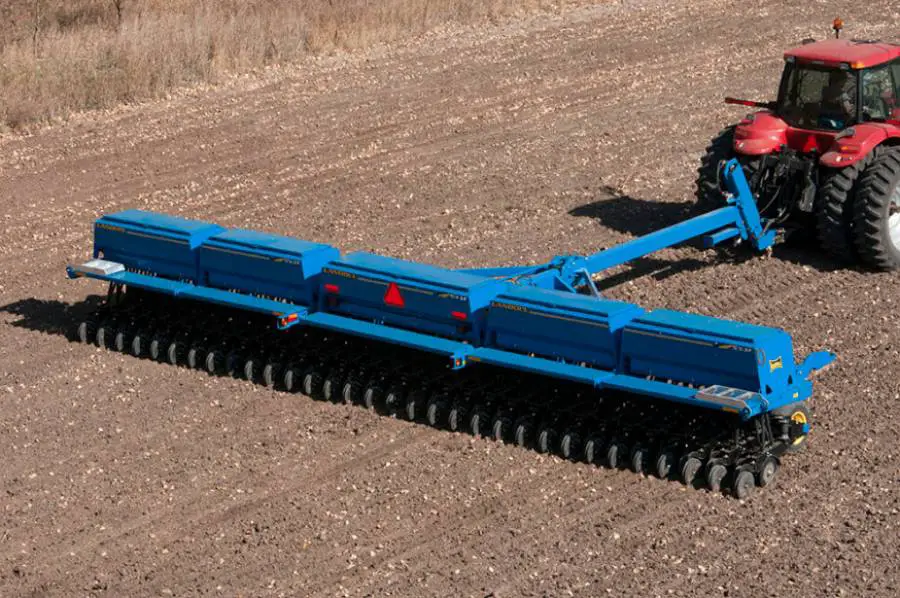
You’d be surprised if an option from the famous brand, Landoll, doesn’t make this of the best no-till drills for pasture.
The Landoll 5211 starts as the only grain drill in its category to feature the pneumatic pressure on the openers. But there’s more to this heavy-duty drill.
Another noticeable feature of this machine is the availability of 3 box options ranging from 10 to 20 feet to enable extensive field seeding.
Of course, it works for any combination of seeds, fertilizers, or grass seeds, so you won’t have to worry about versatility.
Talking about versatility, the 5211 has an optional pull-type hitch that you can add to its standard three-point hitch.
This option creates the possibility of using the 5211 for no-till, min-till, and conventional seeding.
Other features that add to the versatility of this machine include standard strips, large-diameter blades, and a set of swivel-type press wheels.
An externally fluted allows for easier control of seed populations. This meter design also allows users to work with a broader range of seed sizes.
Finally, we found that the meter is easy to clean. Of course, the three-box option allows producers to blend different seed categories in one pass.
What We Like About This Product
- The most significant benefit of this machine is its versatility which allows you to plant different seeds simultaneously.
- Works for both seeding and fertilizing.
- Easy to clean and maintain.
What We Dislike About This Product
- It is not the fanciest option on the list.
- It works better on dry land than in wet conditions.
Best No-Till Drill For Pasture – Buying Guide
A no-till drill can be one of the most valuable farm tools in the hands of any producer if utilized with the right system.
They are designed to increase efficiency, boost profitability and improve environmental stewardship.
However, it would be best to buy what suits your production needs to enjoy these benefits.
Fortunately, several factors can point you in the right direction when choosing a no-till drill. Here, let’s talk about some of them.
Operating Width
Different no-till drills have different operating widths. This operating width directly impacts the total time it’ll take to establish a given crop.
So farmers who want a quicker ground coverage rate will typically go for drills with larger operating widths.
However, you must note that more operating width means that you’ll need more tractor power to pull the machine. So it’s always important to balance both factors.
But if your tractor’s capacity is up for the task, you can go for a drill with a more prominent operating width.
Power Requirements
This one’s a no-brainer – you’d want to consider power requirements when choosing a drill.
Unfortunately, no-till drills require more power than tillage drills because of their weight and functionality. But that doesn’t mean you should jump on any drill.
You’d want to know what works for your tractor. Power requirements constrain the number of openers you can pull with a given tractor.
Surface Smoothing Capabilities
The no-till drilling technology takes away the opportunity to smooth the ground before drilling.
Thus, you need drill openers that can faithfully follow significant soil surface changes without affecting the drill depth or function.
Unfortunately, not all drills can do this, and that’s why you must emphasize this demanding requirement when buying a no-till drill.
It’s a significant factor for planters because the accuracy of seed selection and final spacing will be affected by the ability of the drill to smoothen surfaces during the ride.
Product Storage And Metering
Most modern no-till drills are versatile enough to handle seeds, fertilizers, and insecticides.
However, there’s always the need for openers to be spaced widely apart to clear surface residues during the process. Unfortunately, not all brands consider this.
So while you’re looking out for the most innovative tillers, we also recommend looking out for this.
Wrapping Things Up
There you have it, a detailed review of some of the best no-till drills for pasture available today.
No-till drills have come a long way, and more brands are learning to add exciting new features to their machines.
One crucial point to note is that no-till drills feature different holding capacities.
Some can carry just a few pounds of seeds, while others can carry hundreds or even thousands of pounds.
Whatever the case, it’s always important to look beyond physical designs when choosing a drill.
All the options we’ve listed here have unique features and functionalities. But you want to buy one that suits your specific farming needs.

![Best Curved TV Stands In 2021 [Reviews] Best Curved TV Stands In 2021 [Reviews]](https://homesteadandprepper.com/wp-content/uploads/2021/09/Best-Curved-TV-Stands-Reviews-150x150.jpg)





